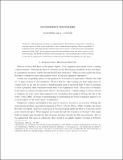Files in this item
Inconsistent boundaries
Item metadata
| dc.contributor.author | Weber, Z. | |
| dc.contributor.author | Cotnoir, A.J. | |
| dc.date.accessioned | 2015-12-01T00:11:48Z | |
| dc.date.available | 2015-12-01T00:11:48Z | |
| dc.date.issued | 2014-12 | |
| dc.identifier | 161262922 | |
| dc.identifier | 63e5e92e-5e83-46a0-897c-05dab5429e16 | |
| dc.identifier | 84939960599 | |
| dc.identifier | 000354385300002 | |
| dc.identifier.citation | Weber , Z & Cotnoir , A J 2014 , ' Inconsistent boundaries ' , Synthese , vol. In Press . https://doi.org/10.1007/s11229-014-0614-z | en |
| dc.identifier.issn | 0039-7857 | |
| dc.identifier.other | ORCID: /0000-0003-4528-7570/work/65702591 | |
| dc.identifier.uri | https://hdl.handle.net/10023/7873 | |
| dc.description | Research on this paper was supported by a grant from the Marsden Fund, Royal Society of New Zealand. | en |
| dc.description.abstract | Mereotopology is a theory of connected parts. The existence of boundaries, as parts of everyday objects, is basic to any such theory; but in classical mereotopology, there is a problem: if boundaries exist, then either distinct entities cannot be in contact, or else space is not topologically connected (Varzi in Noûs 31:26–58, 1997). In this paper we urge that this problem can be met with a paraconsistent mereotopology, and sketch the details of one such approach. The resulting theory focuses attention on the role of empty parts, in delivering a balanced and bounded metaphysics of naive space. | |
| dc.format.extent | 350202 | |
| dc.language.iso | eng | |
| dc.relation.ispartof | Synthese | en |
| dc.subject | Mereology | en |
| dc.subject | Paraconsistent logic | en |
| dc.subject | Spatial representation | en |
| dc.subject | BC Logic | en |
| dc.subject.lcc | BC | en |
| dc.title | Inconsistent boundaries | en |
| dc.type | Journal article | en |
| dc.contributor.institution | University of St Andrews. University of St Andrews | en |
| dc.contributor.institution | University of St Andrews. Philosophy | en |
| dc.identifier.doi | 10.1007/s11229-014-0614-z | |
| dc.description.status | Peer reviewed | en |
| dc.date.embargoedUntil | 2015-12-01 |
This item appears in the following Collection(s)
Items in the St Andrews Research Repository are protected by copyright, with all rights reserved, unless otherwise indicated.

